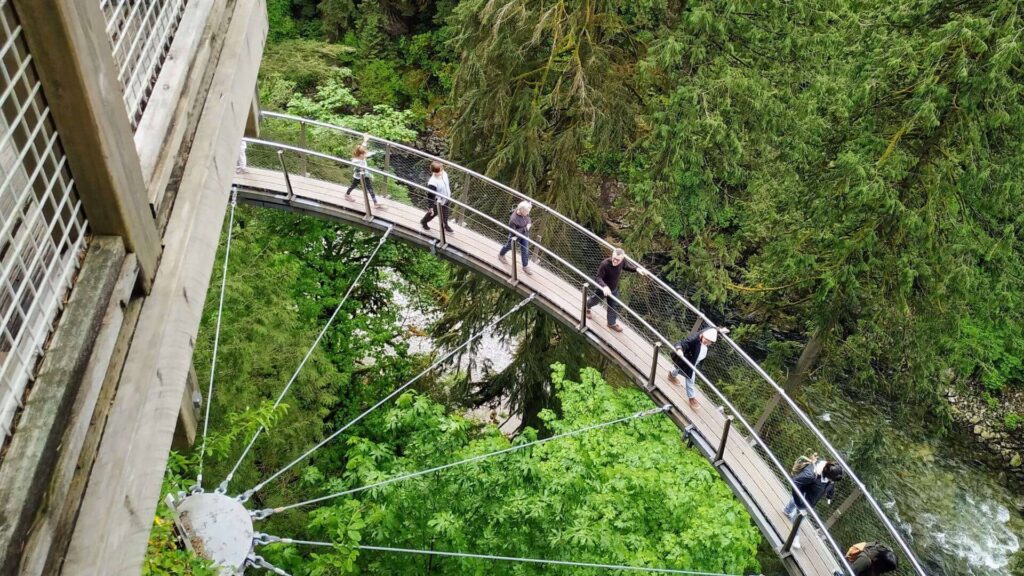Nestled amidst the lush forests of North Vancouver, British Columbia, the Capilano Suspension Bridge serves not just as a crossing over the Capilano River, but as a passage into a world of natural beauty and historical significance. The bridge is not merely a feat of engineering; it’s an emblematic landmark that has captured the imagination of visitors for more than a century. In this article, we will explore the various facets that make the Capilano Suspension Bridge a must-visit destination.

A Brief History
Built initially in 1889 by George Grant Mackay, a Scottish civil engineer and park commissioner for Vancouver, the original structure was made of hemp ropes and cedar planks. Over the years, the bridge has undergone several renovations to enhance its safety and structural integrity. However, it has retained its authentic charm and offers an undiluted experience of the surrounding nature.
Engineering Marvel
Measuring 450 feet in length and suspended 230 feet above the Capilano River, the bridge is an engineering spectacle. Built to withstand the harshest weather conditions, it continues to provide a safe and thrilling experience for its visitors. The wooden planks underfoot creak just enough to remind you of the adventure you’re undertaking, and the wire cables are as strong as they are slender, offering a seamless blend of nature and engineering.
Natural Beauty
The surroundings of the Capilano Suspension Bridge are as breathtaking as the structure itself. The bridge is enveloped by the temperate rainforest that characterizes the Pacific Northwest. A cornucopia of fir, spruce, and cedar trees tower above, offering a lush backdrop and oxygen-rich air. The ripples of the Capilano River below seem to applaud your courage as you make your way across.
Activities and Attractions
Capilano Suspension Bridge Itself
The main attraction is, of course, the Suspension Bridge. Visitors can walk across the 450-foot bridge, suspended 230 feet above the Capilano River. The experience offers panoramic views of the lush forest and rushing waters below.

Cliffwalk
A thrilling cantilevered walkway, the Cliffwalk clings to the granite cliffs of Capilano Canyon. This adventure allows you to walk on a series of narrow, suspended pathways that are jutting out from the cliff face. It provides spectacular views and offers a unique perspective on the surrounding natural beauty.
Treetops Adventure
This attraction consists of seven smaller suspension bridges attached to eight 250-year-old Douglas firs. It gives you the opportunity to see the forest from a squirrel’s eye view, walking from one magnificent tree to another, up to 110 feet above the forest floor.
Treetops Adventure
For those who want to explore the towering trees from up high, the Treetops Adventure offers a unique vantage point. This attraction consists of seven smaller suspension bridges that connect the evergreens and give visitors a squirrel’s eye view of the forest.
Story Centre and Kia’palano
Learn about the history of the Capilano Suspension Bridge, from its creation in 1889 to its current status as a modern marvel. The Story Centre offers historical insights, and Kia’palano educates visitors about the First Nations culture and the significance of the totem poles found in the park.
Raptors Ridge Birds of Prey
This seasonal exhibit gives visitors an up-close experience with birds of prey such as hawks and falcons. It’s educational and exciting, especially for children and anyone interested in wildlife.
Kia’palano
Kia’palano is a significant cultural and educational exhibit at the Capilano Suspension Bridge Park that aims to honor and showcase the rich heritage of the First Nations people of British Columbia. Featuring an array of intricately carved totem poles, the area serves as an open-air museum where visitors can learn about the symbolism and stories behind these sacred structures. Totem poles are an integral part of First Nations culture, each one telling a unique story or representing a particular lineage. At Kia’palano, visitors can deepen their understanding of indigenous history and traditions, while appreciating the craftsmanship involved in creating these cultural landmarks.
Seasonal Events
Throughout the year, the Capilano Suspension Bridge Park hosts several seasonal events. Perhaps the most famous is the Canyon Lights winter festival, where hundreds of thousands of lights illuminate the bridge and the surrounding forest, creating a magical environment.
Guided Tours and Nature Walks
To make the most of your experience, consider joining one of the guided eco-tours available throughout the day. These tours give a deeper understanding of the rich biodiversity of the Pacific Northwest rainforest.
The Trading Post Gift Shop
Before leaving, be sure to stop by the Trading Post Gift Shop. This shop offers a wide range of souvenirs, crafts, and native artwork, providing you with a chance to take a piece of the Capilano experience back home with you.
Eco-Friendly Initiatives
In keeping with its natural setting, the Capilano Suspension Bridge Park follows several eco-friendly practices. These include recycling programs, the use of biofuels, and educational initiatives that teach visitors about the local flora and fauna.
How to get to capilano suspension bridge ?
Getting to the Capilano Suspension Bridge can vary depending on your starting location and preferred mode of transportation. Here are some general guidelines for reaching this iconic landmark:
From Downtown Vancouver:
- Public Transit: One of the most convenient and eco-friendly ways to get to the bridge is by using public transit. You can take bus #236 from the Lonsdale Quay SeaBus terminal, which is directly connected to the SeaBus from downtown Vancouver’s Waterfront Station. The bus will take you directly to the Capilano Suspension Bridge.
- Driving: If you prefer to drive, it’s a relatively short trip from downtown Vancouver. Head west on W Georgia St and then take a slight right onto Stanley Park Causeway. Continue onto Hwy 1A/Hwy 99, and then take exit 14 for Capilano Road. Follow the signs to reach your destination.
- Taxi or Rideshare: You can also use a taxi or ridesharing service like Uber or Lyft. The drive is approximately 15-20 minutes from downtown Vancouver depending on traffic.
- Tour Buses: Some tour companies offer trips specifically to the Capilano Suspension Bridge, usually combined with other local attractions.
From Vancouver Airport (YVR):
- Public Transit: The easiest public transit route involves taking the Canada Line SkyTrain to Waterfront Station. From there, you can take the SeaBus to Lonsdale Quay and then catch bus #236 to Capilano Suspension Bridge.
- Driving: The drive from Vancouver International Airport to Capilano Suspension Bridge is around 30-40 minutes depending on traffic. You would take Grant McConachie Way out of the airport and then merge onto Arthur Laing Bridge. Follow the signs for Hwy 1A/Hwy 99 and take exit 14 for Capilano Road.
- Taxi or Rideshare: These services are available at the airport and offer a convenient but more expensive option.
From Other Parts of British Columbia:
If you’re coming from other parts of BC, you’ll likely want to get onto the Trans-Canada Highway (Hwy 1) and take exit 14 for Capilano Road, then follow the signs to the bridge.
Remember that parking is available but can be limited during peak times, so arriving early or using public transit is often advisable. Always check the current traffic and transportation updates before heading out.
The Capilano Suspension Bridge is not just a destination but a journey into the heart of nature, history, and engineering. It offers an experience that is both thrilling and educational, making it a perfect outing for families, couples, and solo explorers alike. The bridge and its surrounding attractions stand as a testament to the harmony that can exist between man-made structures and the natural world. With its breathtaking views, fascinating history, and adventurous activities, a trip to the Capilano Suspension Bridge is an unforgettable experience that captivates the soul and ignites the imagination.
Frequently Asked Questions (FAQ)
How long is the Capilano suspension bridge
The Capilano Suspension Bridge is 450 feet (137 meters) long and is suspended 230 feet (70 meters) above the Capilano River in North Vancouver, British Columbia. This iconic structure has been a popular attraction since it was first built in 1889, and it offers breathtaking views of the surrounding forest and river below. Despite its length and height, the bridge is engineered to be a sturdy and safe crossing, giving visitors an exhilarating experience as they traverse from one side to the other. It stands as one of the most visited tourist attractions in British Columbia, drawing visitors from around the world.
What is the Capilano Suspension Bridge?
The Capilano Suspension Bridge is a pedestrian suspension bridge located in North Vancouver, British Columbia, Canada. The bridge spans 450 feet and is suspended 230 feet above the Capilano River.
Where is the bridge located?
The bridge is situated in Capilano Suspension Bridge Park, North Vancouver, just a short drive or public transit trip from downtown Vancouver.
How much does it cost to enter the park?
Ticket prices can vary depending on age and the package you choose. It’s best to check the official website for the most up-to-date pricing information.
Adult 18-64 years – CAD $66.95 – (Approx. USD $54)
Senior 65 years+ (- CAD $61.95 Approx. USD $50)
Student 18 years+ – CAD $53.95 (Approx. USD $44)
Student ID required to be presented on arrival
Youth 13-17 years – CAD $36.95 (Approx. USD $32)
Child 6-12 years – CAD $26.95 (Approx. USD $23)
Can I take guided tours?
Yes, guided eco-tours are available and they offer insights into the rich biodiversity and history of the area.
Are there age or height restrictions?
There are no specific age or height restrictions mentioned at the moment, but it’s recommended that children be closely supervised.
What is the Canyon Lights event?
Canyon Lights is a winter festival where the bridge and surrounding areas are illuminated with hundreds of thousands of lights, creating a magical atmosphere.
Is parking available?
Yes, parking is available but may be limited during peak times. Public transport is also a convenient option.
